
Anacostia Park needs funding to be its best
WASHINGTON, D.C.— Just northwest of metropolitan Washington D.C., lies a 1,200 acre environmental refuge where the bustling and booming city soundtrack is quieted to little more than a dull roar.
On an early spring day, the air is a bitter 45 degrees and overcast— hardly desirable weather for outdoor activity.
Nonetheless, it is the first regatta of the season and racing boats from local universities glide effortlessly through the water. Dozens of coaches, photographers, students and parents line the shores of the Anacostia River (formerly known as the Eastern Branch of the Potomac River), cheering on their respective teams.
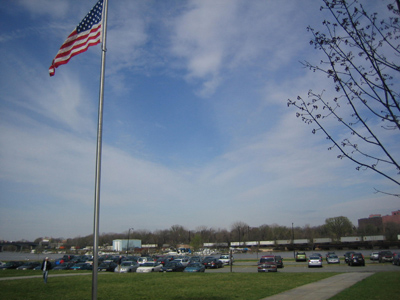 |
An American flag flies near the skating pavilion at Anacostia Park in Washington, D.C. (Photo by Nayda Verier-Taylor). |
Amid the fans are small groups of children and adults walking along the shoreline with oversized work-gloves and plastic trash grabbers, hauling huge orange garbage bags.
Nearby, Wayne D. Phillips, one of two National Park Service rangers on duty in Anacostia Park, is greeting volunteers and hanging up a banner that reads “19th Annual Take Pride in the Potomac River Watershed Cleanup.”
“Please sign-in, grab a nametag, a pair of gloves and a couple of bags to put the trash in,” Phillips, who has been with the National Park Service for 31 years and has been a park ranger for 10, instructs.
Five middle-aged women from a local Bank of America branch approach, shivering. They greet Ranger Phillips warmly by his first name. He’s a regular customer at their bank and, to show their appreciation for his business, they have come out with their friends and family to support their corporation and Anacostia Park by participating in the cleanup.
| Ranger Wayne D. Phillips meets visitors in his office at Anacostia Park (Photo by Nayda Verier-Taylor). | 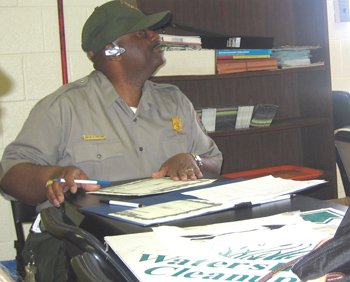 |
“We’ve got volunteers coming from all walks of life today,” Phillips said. “Girl Scouts, Cub Scouts, regular citizens. We’ve been doing this for so many years, but this is the first year that it’s been cold! We’ve been out here in the rain, too. The volunteers never let us down.”
Founded in 1901, Anacostia was a federal government experiment in providing recreational opportunities through a managed flood plain. Over the years, though, urban development has lead to significant habitat loss and contamination of the water along which the park is located.
As a result, there have been intensified efforts in recent years to upgrade and restore the Anacostia River.
“Unfortunately the debris that is polluting our water is a direct result of our bad habits,” Phillips said. “Everything works by gravity here. Most of the watershed contamination is due to stuff that we throw away. Until we stop dumping our trash, the tidal patterns are going to keep bringing it back.”
Hosting more than two million visitors each year, Anacostia is one of the Washington area’s largest and most unique parks. Aside from spanning 11 miles of shoreline from the Frederick Douglass Memorial Bridge all the way to the Maryland state line, it is one of few national parks that is designated for recreational use.
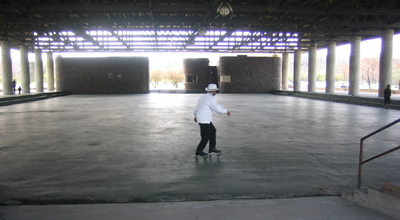 |
A man has the roller skating rink all to himself for some exercise on a spring Saturday morning at Anacostia Park (Photo by Nayda Verier-Taylor). |
Anacostia includes softball fields, picnic areas, basketball and tennis courts and the Anacostia Park Pavilion, which hosts special events and serves as a roller skating rink. It also includes the nearby Kenilworth Park and Aquatic Gardens, Kenilworth Marsh.
“We call our fields multi-purpose fields,” Phillips said. “Not only do they serve as fields for the Ultimate Frisbee League, soccer and softball teams, but they are also designated as First Amendment demonstration areas.”
And for good reason.
In June of 1949 there were race riots in response to the integration of the Anacostia Park public swimming pool. Today, however, qualms aren’t over racial segregation but, rather, socio-economic challenges in the surrounding communities.
Merrit Drucker, a 53-year-old Washington resident and former federal government employee, believes that the surrounding neighborhoods and the park are interconnected.
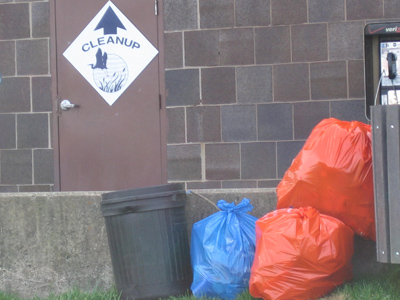 |
A volunteer cleanup effort at Anacostia Park filled these three large bags (Photo by Nayda Verier-Taylor). |
“You go into some of these neighborhoods and it’s pathetic,” Drucker said. “Just minutes from the White House and the poverty is so prevalent. This park will never reach its full potential in this community until the community itself is given the opportunity to reach its own potential.”
Drucker says that there is no excuse for the park and its adjacent neighborhoods to be so rundown.
“Congressmen come out [to Anacostia Park] weekly and play soccer with their staff members,” he said. “No government official can plead ignorance because they see it first-hand all of the time. It’s not ignorance. It’s a lack of compassion.”
According to Phillips, the park service knows more about how to successfully restore the park than ever before, but fluctuation of funding stifles its ability carry-out a lot of its development plans
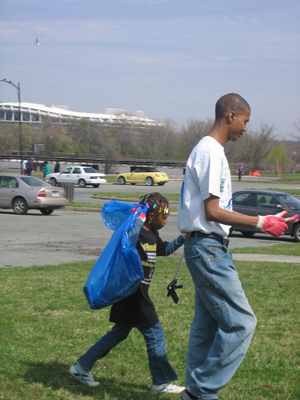 |
Volunteers Jabaru Raleigh and his son Jabaru Raleigh, Jr., help clean Anacostia Park, with Washington’s sports stadium in the background (Photo by Nayda Verier-Taylor). |
“Over the past few years, things have definitely changed for us as far as funding is concerned,” he said. “There is an initiative for 2010-11 that President Bush just signed, endorsing some new money that will help us out for our centennial, but that’s still a few years away.”
Said Drucker, “This park could be a city playground that exemplifies how Congressional far-sighted urban planning can benefit today’s generation and their communities. Instead, though, we’re spending God knows how much money on this war when we have our own problems here at home, minutes from our nation’s Capitol.”
If You Go
- Hours: Dawn to dusk; pavilion is open 10 a.m. to 5 p.m. Mondays to Fridays and 10 a.m. to 7 p.m. on Saturdays and Sundays.
- Admission: Free
- Address: 1900 Anacostia Dr., SE, Washington, D.C. 20020.
- Phone: 202-472-3873; 202-426-6905.
- Web site: http://www.nps.gov/anac/.
- Transport: Getting a taxi can be difficult, so renting a car or taking public transit are preferable. The Metro provides transportation to several Anacostia Park entrances. Entrances one and two are closest to the Anacostia Metro Station on the Green Line. This station is on Howard Road, between Martin Luther King, Jr. and Fifth Sterling Avenues. The third park entrance is closer to the Potomac Avenue Metro Station on the Orange/Blue Lines. This station is located on 14th Street near 14th and G Streets, adjacent to Pennsylvania Avenue. A public parking garage is available across from each of these metro stations.
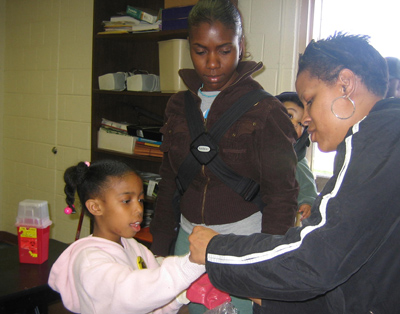 |
Volunteers get ready to help clean up Anacostia Park in Washington, D.C. during the annual spring program (Photo by Nayda Verier-Taylor). |

Comments are Closed